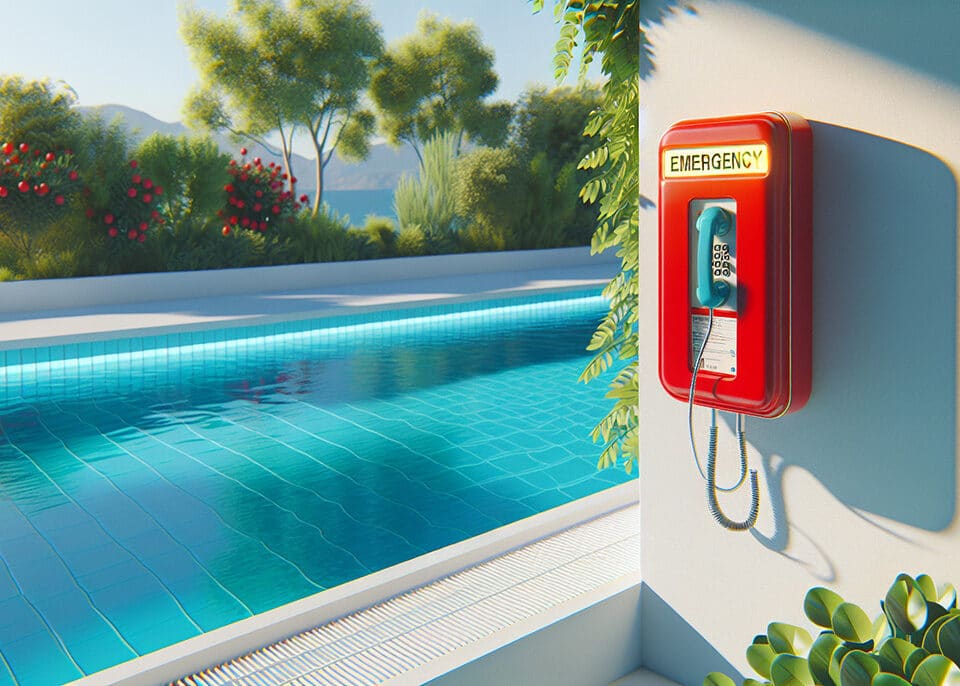
Does an Elevator Require a Dedicated Phone Line?
February 22, 2024
Best Elevator Phone Line Options for Safety and Reliability
April 9, 2024In emergencies, every second counts, and the right emergency phone can be a lifesaver. This guide cuts straight to the heart of what you need to know: the defining traits of emergency phones, their strategic importance, and how to select a model that meets your specific safety needs. We provide the critical criteria empowering you to improve safety and response times where it matters most.
Key Takeaways
- Emergency phones are vital for public safety, with user-friendly features and ADA compliant designs to ensure accessibility and ease of use for all individuals, including those with disabilities.
- Modern emergency phones possess advanced technological features such as IP connectivity for efficient crisis response and enhanced weather protection for durability in harsh conditions.
- Strategic placement, regular maintenance, and integration with other safety measures are crucial for the optimal performance and effectiveness of emergency phone systems in enhancing public safety and emergency response.
The Essentials of Emergency Phones for Public Safety

The role of emergency phones in upholding public safety is pivotal. Designed to offer reliable communications, these devices are strategically placed in various locations, from bustling city streets to remote hiking trails.
Viking emergency phones, for example, powered by the phone line, seamlessly integrate with most Central Station Monitoring equipment, enhancing security across locations, including parking garages.
What Makes a Phone an Emergency Device?
So, what differentiates an emergency phone from a regular device? Emergency phones, at their core, come equipped with user-friendly features designed for facilitating urgent communication during crises. These include:
- The capability to make emergency calls without unlocking the phone
- ICE (In Case of Emergency) contacts
- One-touch emergency calling
- A panic button that issues a silent alarm
These tamper resistant design features enable the user to alert security personnel or emergency services without tipping off any potential threat, taking into account the need for discretion.
ADA Compliant Solutions for Accessibility
Accessibility holds a critical place in an inclusive society. ADA compliant phones improve accessibility by providing standards for:
- Accessible parking
- Ramps
- Elevators
- Entrances
- Communications
- Signage
- And more
Features such as a single push-button auto dialer, call indicator light, pre-recorded location announcement, and a tactile braille label make these devices easy to use for everyone, including individuals with disabilities.
This inclusive design not only ensures accessibility in emergency situations but also promotes ease of use for the general population.
Advanced Features of Modern Emergency Telephones
Today’s emergency phones have evolved beyond mere communication tools; they are now sophisticated technological devices engineered to promote efficient crisis response and coordination. IP connectivity is a prime example of an advanced feature that has revolutionized the functionality of emergency phones. This feature allows the phones to operate over an IP network, providing centralized management and ensuring their durability in various environments.

Enhanced Weather Protection for Durability
For resisting harsh weather conditions, emergency phones are outfitted with superior weather protection features. These features include:
- Heavy gauge aluminum housings
- Sealed keypads
- Rubber gaskets
- Powder-coated heavy-duty steel
These phones promise consistent and reliable performance in a range of outdoor environments.
Whether it’s extreme heat, freezing cold, or heavy rainfall, these devices are built to operate effectively and reliably.
IP Connectivity for Efficient Response
IP connectivity in emergency phones offers several benefits, including:
- Rapid transfer of emergency calls to the relevant response center
- Real-time sharing of information between emergency response centers
- Enhanced efficiency of emergency response
- Prompt assistance for the affected individual
Additionally, the integration of IoT technologies and geolocation systems leads to better accuracy, improved emergency resource allocation, and overall improved safety and effectiveness of emergency response strategies.
Strategic Placement of Emergency Call Stations

The importance of strategically positioning emergency call stations matches that of their design and functionality. It is recommended to position emergency call stations within the line of sight to ensure visibility and accessibility. Moreover, customization based on specific locations like public restrooms or large campuses can optimize the effectiveness of these devices, thereby maximizing public safety.
Importance of Visibility in Emergency Situations
Visibility becomes paramount in emergency situations. A well-placed, easily noticeable emergency phone can mean the difference between a swift response and a missed opportunity for immediate help. Research has shown that blue light emergency phones not only deter crimes but are also preferred by students and parents on campuses, proving the importance of visibility in emergency response.
Customizing for Specific Environments
Customizing emergency phones to suit specific environments can significantly enhance their effectiveness. Whether it’s by utilizing a range of products like blue light emergency phone towers, Lexan call boxes, and retrofit kits, or including specific facility information in signage, customization ensures that the emergency phone system caters to the unique needs of each location.
This, in turn, improves accessibility and visibility in public areas, especially in low-light areas.
Selecting the Right Emergency Phone Model for Your Needs

Selecting an appropriate emergency phone model is instrumental in guaranteeing effective communication during crises. While an industrial phone might be best suited for a factory or warehouse, an indoor phone would be the ideal choice for office buildings and elevators. Each phone model has unique features tailored to specific needs and environments, ensuring that help is always within reach.
Industrial-Strength Options for High-Durability Areas
Industrial-grade emergency phones are built to withstand the harshest conditions. With features like automatic noise canceling, multi-function intercom, and a design that withstands extreme temperatures and severe weather conditions, these phones ensure reliable communication in even the most challenging environments.
Brands like Viking Electronics and Guardian Telecom are renowned for their robust and reliable industrial-grade emergency phones.
Indoor Emergency Phones for Offices and Elevators
In indoor environments like offices and elevators, emergency phones need to be easily accessible and simple to use. Models designed for indoor use often feature a streamlined interface, a single button for simplicity, and the capability to support one-way or two-way conversations.
Regular testing and professional installation ensure these phones are always ready to connect and provide a lifeline in times of need.
How to Maintain and Test Your Emergency Phone Systems
The longevity and optimal performance of your emergency phone systems hinge on their regular maintenance and testing. Regular maintenance not only minimizes the need for emergency maintenance but also helps maintain consistent functionality. Hence, it is recommended to conduct regular tests and maintain records for inspection, testing, and maintenance.
Routine Checks and Balancing
The continual optimal functioning of your emergency phone systems is ensured by integral routine maintenance and balance checks. Regular checks should be conducted monthly for 30 seconds and annually for 90 minutes. Furthermore, federal law mandates that the systems must be tested at least once every three years.
Upgrading and Retrofitting Older Systems
Upgrading or retrofitting older emergency phone systems is a valuable investment for your security infrastructure. With technological advancements, old systems may become obsolete or less efficient. Retrofitting these systems with new technology not only overcomes limitations but also ensures compliance with safety regulations and improves overall security.
Integrating Emergency Phones with Other Safety Measures

Merging emergency phones with other safety protocols like surveillance and alarms can result in a comprehensive safety solution. The rapid caller location and automatic alerts to security teams during emergencies enhance the overall efficiency and response speed.
Coordination with Surveillance and Alarms
When integrated with surveillance and alarm systems, emergency phones provide a seamless and effective security solution. This integration facilitates:
- Rapid response
- Improved communication
- Coordination between different response teams
- Situational awareness through real-time communication and remote monitoring capabilities
Training Staff and Users on Proper Use
Efficient utilization of emergency phones is largely dependent on appropriate training of staff and users. Training should include how to conduct call assessments, implement mobile technology for improved efficiency, and urge users to directly call 9-1-1 during emergencies.
Regular mock drills and feedback systems ensure that users are well-acquainted with the correct usage of emergency phones in real emergency situations.
Case Studies: Success Stories of Emergency Phone Deployment
The effectiveness of emergency phones is evidenced by concrete real-life examples. From university campuses to public spaces, these devices have proven their worth time and again. Whether it’s improving response times, averting crimes, or saving lives, emergency phones have consistently demonstrated their vital role in public safety.
Campus Security Enhancements with Emergency Phones
The use of emergency phones brings a significant enhancement to campus security. These devices provide a direct communication channel, facilitating rapid and reliable communication, thereby bolstering emergency preparedness.
Furthermore, their presence on campus has been proven to deter crimes, proving their effectiveness in enhancing campus security.
Life-Saving Accounts from Public Spaces
In numerous life-saving situations in public spaces, emergency phones have played a crucial role. Their presence has not only deterred crimes but also provided a lifeline in dire situations. They have demonstrated their reliability in enhancing public awareness, improving response, and promoting protective behavior during crisis situations.
Summary
Emergency phones are a crucial component of public safety infrastructure. From their strategic placement and advanced features to regular maintenance and integration with other safety measures, these devices play a pivotal role in ensuring swift and effective response during emergencies. As we move forward, continued innovation and improved accessibility will only serve to enhance their functionality and reliability, safeguarding public safety in an increasingly unpredictable world.
Frequently Asked Questions
How can I use my phone as an emergency?
You can use your phone for emergencies by setting up Emergency SOS in your phone settings. Simply go to Settings, tap Privacy, tap Emergency SOS, and enable the option to send an SOS message to your emergency contacts.
What are the emergency numbers in USA?
In the USA, the nationwide emergency number is 911. It is used for emergency response.
What is emergency call on cell phone?
Emergency call on a cell phone allows you to reach 911 for urgent assistance, but it can be challenging because wireless phones are not associated with a fixed location. If your lock screen is enabled, you can access the “Emergency call” option to dial the number for your local emergency services.



